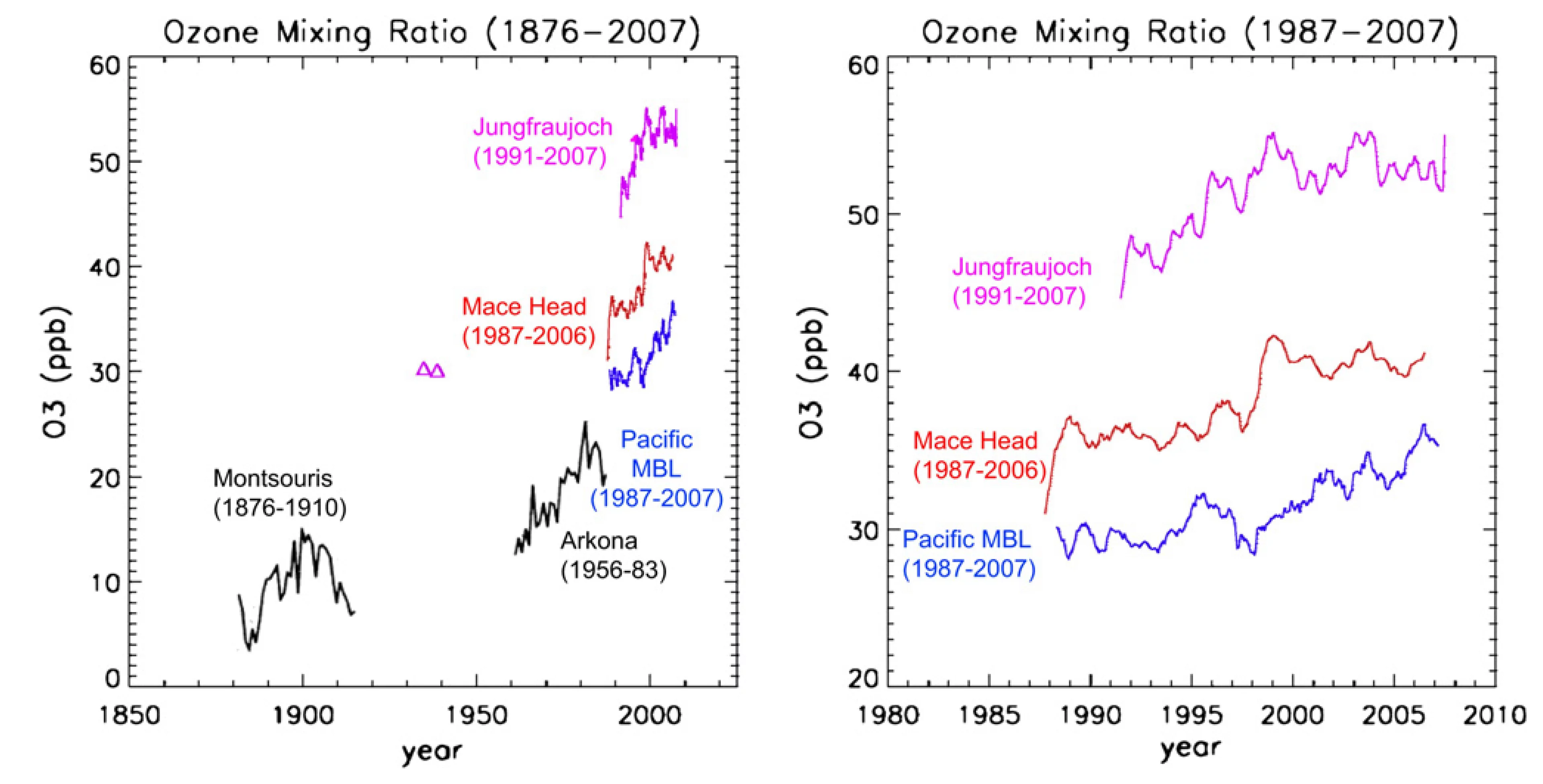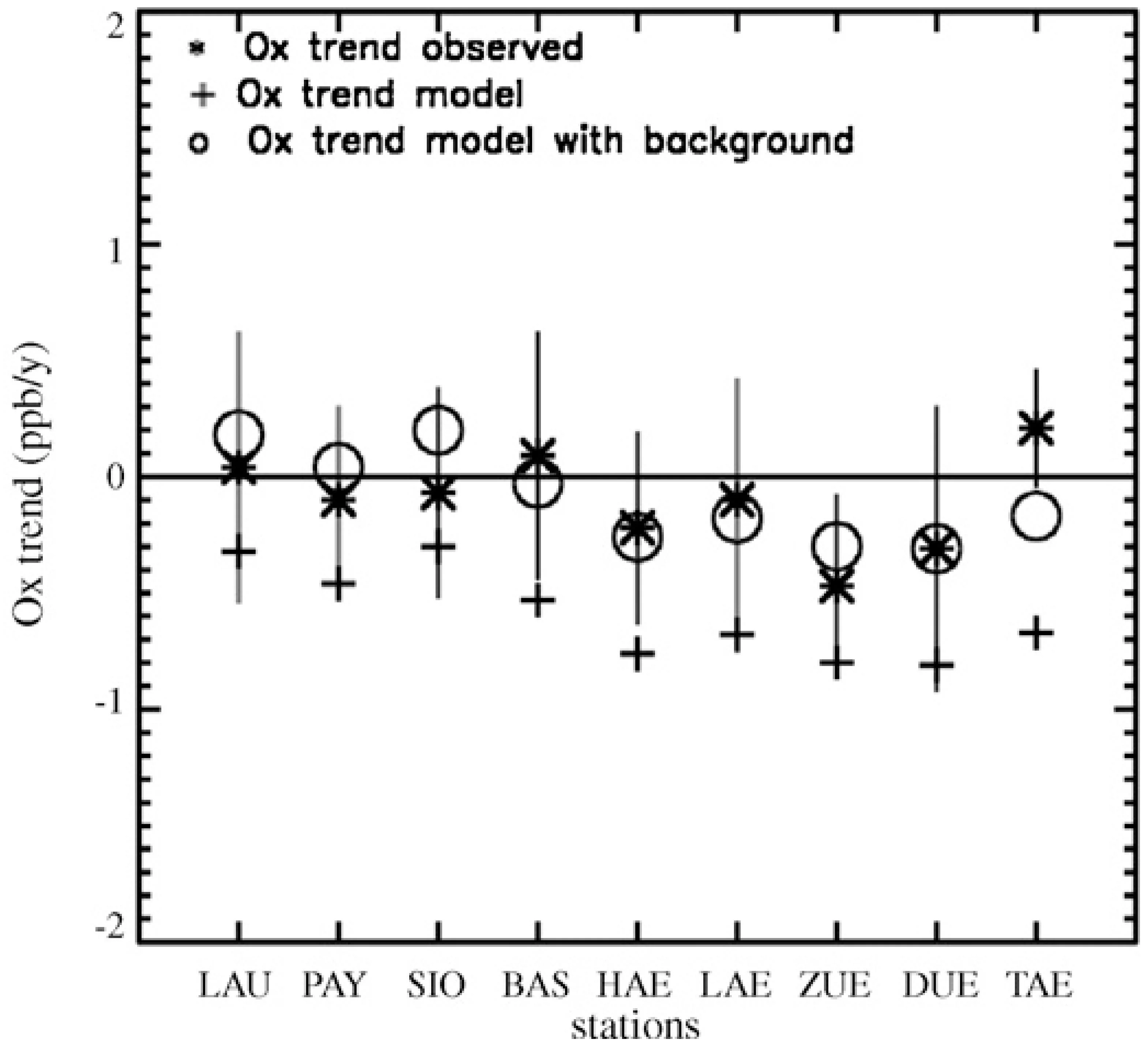Scope of project
Statistical analyses of long-term measurements using measurements of ozone and nitrogen dioxide to derive the variability of PM as a function of meteorology, season, weekday and their trends.
Key findings
- For most low altitude stations (12) in Switzerland, no significantly negative trends (at the 95% confidence level) of the summer medians
of daily O3 or Ox (O3+NO2) maxima were found in the period 1992-2002 despite the significant reduction in the precursor emissions in Central
- Significant downward trends in the summer 90th percentiles of daily Ox maxima (1992-2002) were observed at 6 sites in the region around Zürich (on average −0.73 ppb yr−1 for those sites) (Ordonez et al., 2005).
- In summer and spring, afternoon temperature and morning radiation were the variables that accounted for most of the meteorological variability in afternoon ozone maximum concentrations (Ordonez et al., 2005).
- In 2003, the measured daily ozone maximum was 15 ppb (nearly 29%) higher than in the reference period summer 1992–2002, corresponding to an excess of 5 standard deviations of the summer means of daily ozone maxima in that period. The high concentrations can be explained by the meteorological factors influencing ozone (Ordonez et al., 2005).
- There is evidence of a dominant influence of changes in lowermost stratospheric ozone on the variability and overall upward trend of background ozone in the lower troposphere (3000–3500 m asl) during the 1992–2004 period (Ordonez et al., 2007).
- Model predictions match very well the spatial variability of the trends but the calculated trends are around 0.5 ppb year−1 lower than those observed. This difference is similar to the background ozone increase as suggested by the long-term observations at the high Alpine station Jungfraujoch. These results support the hypothesis that the decrease in local ozone production due to emission reductions might have been partly or completely compensated by the simultaneous increase in the background ozone (Andreani-Aksoyoglu et al., 2008)
- Ozone mixing ratio significantly increased at Jungfraujoch (JFJ), Switzerland but decreased at the Caucasian Kislovodsk High Mountain Station (KHMS)from 1990 to 2006. In the years 1990-1993 concentrations were comparable, while at the end of the period 2004-2006 concentrations at JFJ were 15 ppb higher (Tarasova et al., 2009)
- Concentration increased at JFJ until around 2000 and then increased only little or stayed rather constant (Tarasova et al., 2009; . At the west coast of the United States, ozone still significantly increased in the same period (Isaksen et al., Fig. 15, 2009).
- Compared to the 1940s, ozone concentrations at Jungfraujoch increased more than 20 ppb until 2005 (Isaksen et al., Fig. 15, 2009).
Publications
Journal Articles
Influence of various emission scenarios on ozone in Europe.Andreani-Aksoyoglu, S., J. Keller, C. Ordóñez, M. Tinguely, M. Schultz, and A. S. H. Prevot, 2008
Ecological Modelling, 217, 209-218.
Atmospheric composition change: Climate-chemistry interactions.
Isaksen, I. S. A., C. Granier, G. Myhre, T. K. Berntsen, S. B. Dalsören, M. Gauss, Z. Klimont, R. Benestad, P. Bousquet, W. Collins, T. Cox, V. Eyring, D. Fowler, S. Fuzzi, P. Jöckel, P. Laj, U. Lohmann, M. Maione, P. Monks, A. S. H. Prevot, F. Raes, A. Richter, B. Bognerud, M. Schulz, D. Shindell, D. S. Stevenson, T. Storelvmo, W.-C. Wang, M. van Weele, M. Wild, and D. Wuebbles, 2009
Atmos. Environ., 43, 5138-5192.
Changes of daily surface ozone maxima in Switzerland in all seasons from 1992 to 2002 and discussion of summer 2003.
Ordóñez, C., H. Mathis, M. Furger, S. Henne, C. Hüglin, J. Staehelin, and A. S. H. Prévôt, 2005
Atmos. Chem. Phys., 5, 1187-1203.
Strong influence of lowermost stratospheric ozone on lower tropospheric background ozone changes over Europe.
Ordóñez, C., D. Brunner, J. Staehelin, P. Hadjinicolaou, J. A. Pyle, M. Jonas, H. Wernli, and A. S. H. Prevot, 2007
Geophys. Res. Lett., 34, L07805, doi:10.1029/2006GL029113.
Surface ozone at the Caucasian site Kislovodsk High Mountain Station and the Swiss Alpine site Jungfraujoch: data analysis and trends (1990-2006).
Tarasova, O. A., I. A. Senik, M. G. Sosonkin, J. Cui, J. Staehelin, and A. S. H. Prevot, 2009
Atmos. Chem. Phys., 9, 4157-4175.
Thesis
Trend analysis of ozone and evaluation of nitrogen dioxide satellite data in the troposphere over EuropeOrdonez, Carlos, 2006
Funding
Federal Office for the Environment (FOEN)
Swiss National Science Foundation (SNSF) (JRP IB7320-110831)




